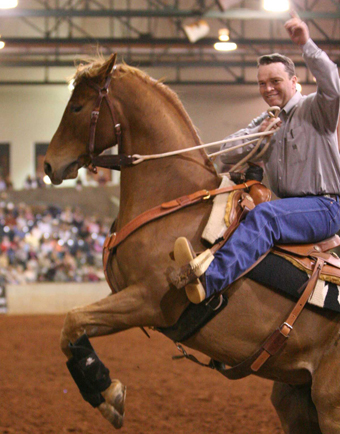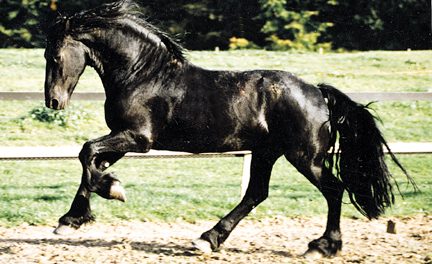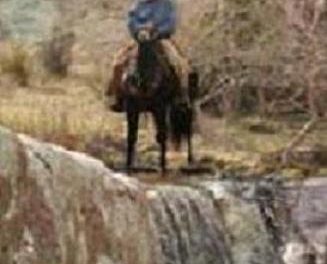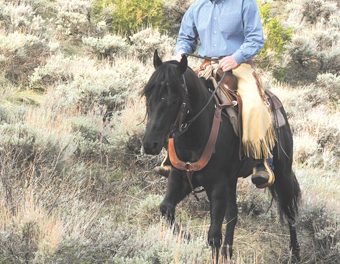 This month we’ll conclude our three part series on colt starting. We’re going to use a technique that I like for a colt that is being especially difficult or broncy. There are other ways of starting your colt, and this way takes the help of an experienced rider or professional trainer and the help of a calm, broke horse. I want to stress that the exercises we use here are not for every horse and rider. Remember that your safety and your horse’s safety is always top priority, and only do these exercises to the extent that you are comfortable and confident.
This month we’ll conclude our three part series on colt starting. We’re going to use a technique that I like for a colt that is being especially difficult or broncy. There are other ways of starting your colt, and this way takes the help of an experienced rider or professional trainer and the help of a calm, broke horse. I want to stress that the exercises we use here are not for every horse and rider. Remember that your safety and your horse’s safety is always top priority, and only do these exercises to the extent that you are comfortable and confident.
For these exercises, you will need two horses, both the colt you are starting and a calm, broke horse that you can rope off of, and that will move off your leg and can be ridden one handed. Both horses should be saddled and have protective boots on all four legs. It’s very important to have boots on all four legs for this, not just the front legs. You will want the usual rope halter with a 12’ lead rope on the colt, and your bridle on the broke horse.
Start in the round pen, riding your broke horse and leading your colt. Let the colt follow you around, and move your horse into his space so your colt sees you above him. Basically you are riding him from the outside, putting yourself in the same space where you will be when you ride him without actually getting on his back. Lean over and rub your colt’s neck. Slap the seat of the saddle he is wearing, and generally let him get used to having someone above him. Sack him out with the end of the lead rope. It is so important through this whole process that your broke horse stays calm and sets a good example no matter what your colt does. As you work around your colt, be careful not to get your toe in a position where it could get caught in the stirrup of his saddle if he jumped forward. Work him from both sides until he is relaxed and comfortable. I like to spend a lot of time ponying a colt, especially one that’s being a little extra challenging to start under saddle.
Ask your broke horse to step in to your colt, and have him move his shoulders and hips. This establishes respect. I also like to rope the saddle horn on my colt’s saddle as he moves around the round pen and pull on it a little, allowing him to get used to the feel of the saddle moving and the cinch pulling, just as it will when you go to step into the saddle for the first time.
Once your colt is comfortable with your being above him and doesn’t mind the movement and pulling of the saddle, you are ready to bring in whoever will ride the colt. This person should be experienced and able to stay calm and relaxed even if the colt gets excited or acts up. Dally the colt up to your saddle horn, leaving him only 8-10” of slack in the lead rope. This gives you a little control in order to help your rider out if he needs it. Have your rider pet your colt and get to know him a little bit, and position your broke horse so the colt has somewhere to go if he jumps away from the rider. Have your rider put one foot in the stirrup and take it right back down. Practice this a few times, then progress to stepping up in the stirrup and stepping right back down. As your colt gets more comfortable and relaxed, step up and stay for a little longer. Lean in to the saddle so he can feel your weight, and reach up and pet him on the neck. Remember not to sneak around your horse for this, it will just make him nervous if all your movements are tentative.
Once he is comfortable with your rider stepping up and down in the stirrup on both sides, you can progress to swinging your leg over to sit in the saddle for just a second. Swing up and swing off smoothly and immediately. As you did when you were stepping up in the stirrup, linger a little longer in the saddle after a few times. Rock the saddle gently back and forth and pet your horse on the neck. Repeat these steps as much as you need to for your colt to be very relaxed. Ask your broke horse to move off just a little, and pony your rider around the pen a little at a time. Make sure you keep petting and praising your colt the entire time.
After your colt is doing well and is comfortable with all of this, you can loop the lead rope around his neck and tie it to make reins. Have your rider get on the horse, and remember that it’s important not to change how he or she is sitting or doing anything. Don’t let anyone get nervous because you are not ponying the young horse any more. Move your broke horse off and let the young horse follow you around the pen. If he starts to buck or get in a wreck at any point now, the best thing you can do is stay calm and stay out of the way.
Don’t push things or make the first ride last too long. Find a positive place to quit for the day, and put your colt away. Take it slow and practice all the steps as much as you need to.
Enjoy your horses and, until next time, may God bless the trails you ride.
For more information on Ken McNabb’s programs call us at 307-645-3149 or go to www.kenmcnabb.com




